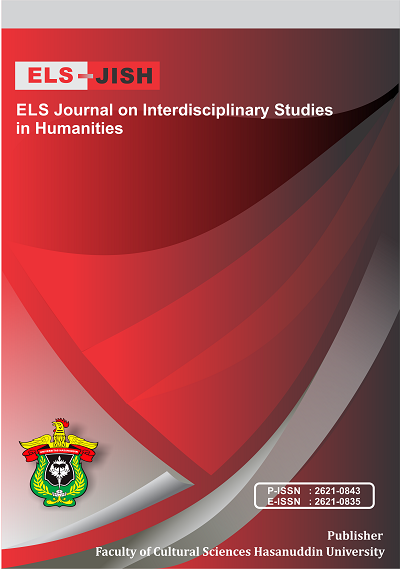Students' Perceptions of the Strategies Used by Teachers in Teaching Speaking in Desa Bahasa Sragen
DOI:
https://doi.org/10.34050/elsjish.v3i4.11750Keywords:
Students’ Perception, ,Strategies, Speaking, Desa Bahasa SragenAbstract
The objective of this study was to determine students' perceptions of the teaching strategies used by teachers to teach speaking in “Desa Bahasa Sragen”. The subjects of this study were the six students of the “Desa Bahasa Sragen”. There are six students who voluntarily agreed to be participants in this study. The instruments used to gather data was interviews. The case study is used in this research as a research method. The results showed that the students gave a positive perception of the strategies used by the teacher in teaching speaking in “Desa Bahasa Sragen”. They stated that the strategies used by the teacher in teaching speaking in “Desa Bahasa Sragen” could help them practice speaking, making them feel the learning process fun. In addition, their positive perceptions are influenced by the new experiences they get while learning English, especially speaking in “Desa Bahasa Sragen”.
References
Ahmadi, A. (2013). Psikologi Belajar. Jakarta: Rineka Cipta.
Ary, J. et al. (2002). Introduction To Research In Education. Belmont: Wadsworth
Cole. R. W. (2008). Educating Everybody’s Children: Diverse Teaching Strategies for Diverse Students, Revised and Expanded 2nd ed. Virginia: Association for Supervision and Curriculum Development (ASCD).
Creswell, J. W. (2012). Educational research: Planning, conducting, and evaluating quantitative and qualitative research. Boston: Pearson Education, Inc.
Gibson, J.L., Ivancevich, J. M., and Donally, J.H. (1996). Teacher efficcacy: A construct validation. Journal of Education Psycology, 76, 569-582.
Isjoni. (2009). Pembelajaran Kooperatif: Meningkatkan Kecerdasan Komunikasi Antar Peserta Didik. Yogyakarta: Pustaka Belajar.
Kotler, P. (2000). Analysis, Planning, Implementation and Control. New Jersey: Prentice Hall International, Inc.
Nichols, R. (2007). Thomas Reid’s Theory of Perception. Oxford: Oxford University Press.
Hasria, R. S., Fathu, R., & Andjarwati, S. (2018). Improving the students’ speaking ability through Silent Way Method at SU Negeri 12 Makassar. Journal Ilmu Budaya. 6, 303-312. https://doi.org/10.34050/jib.v6i2.4289
Junaidi, J., Hamuddin, B., Julita, K., Rahman, F., Rianita, D., & Derin, T. (2020). Artificial Intelligence in EFL Context: Rising Students’ Speaking Performance with Lyra Virtual Assistance. International Journal of Advanced Science and Technology, 29(5), 6735 –6741.
Reiser, R. A., & Dick, W. (1996) Teacher Planning and Instructional Design: A New Perspective. Paper presented at the meeting of the association for educational communications and technology, Indianapolis.
Robbins, J. (1996). Between "Hello" and "See you later": Development of strategies for nterpersonal communication in English by Japanese EFL students. Published Dissertation. Michigan Universtity Press: Ann Arbor.
Robbins, S. (2002). Prinsip-Prinsip Perilaku Organisasi (Edisi Kelima). Jakarta: Erlangga.
Robbins, S. (2013). Organizational Behavior (15th Edition). Prentice Hall.
Ruslan, R. (2010). Manajemen Public Relation dan Media Komunikasi. Jakarta: Rajawali Pers.
Walgito, B. (2010). Pengantar Psikologi Umum. Yogyakarta: Andi Ofset.
Downloads
Published
Issue
Section
License

This work is licensed under a Creative Commons Attribution-NonCommercial 4.0 International License.






